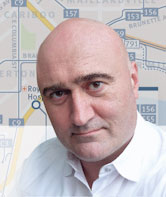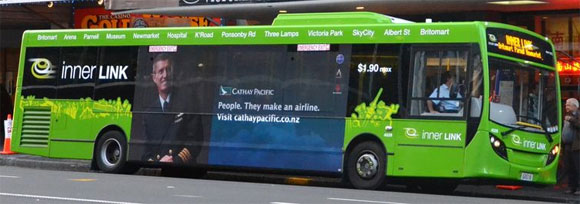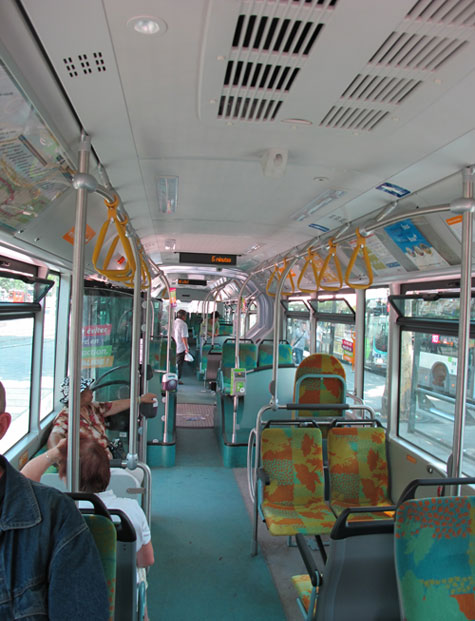I first became aware of Jarrett Walker's work through his blog, Human Transit, a few years ago. Here was someone writing about transit in a completely refreshing way, framing questions not in terms of mode or technology but through the prism of values and desires. To call Walker's site a transit blog doesn't quite do it justice. It's about what we want from our cities, and how transit can help us get there. His 2011 book, Human Transit: How clearer thinking about public transit can enrich our communities and our lives, is a must-read if you're interested in cities and want to understand what makes transit work well.
A transit planning consultant by trade whose clients literally span the globe, Walker will be in NYC next month to lead his two-day workshop in transit network design (as of press time, a few spaces are still available) and give a talk at the New School on the evening of February 6 (no registration required). When we first got in touch about doing an interview, he was about to leave for a gig in New Zealand for several weeks. A few days ago we caught up for a discussion that touched on transit on three continents, why simplicity matters in transit networks, and the legibility of New York City's bus system.
The interview has been lightly edited for length and clarity.
Can you tell us a bit about what you were working on in New Zealand?
I have been working in New Zealand on and off for five years now. The main project that brings me down there over and over is a complete redesign of the bus system in Auckland. Working with my New Zealand colleagues from a firm called MR Cagney, I led workshops with Auckland transit staff that completely redesigned the network, with the goal of much higher ridership and much higher levels of freedom for almost everyone. Aucklanders will see that network rolling out over the next few years. And since then I’ve been back there several times to help them work on the details. There are lots of interesting details around what the buses do downtown and how that interacts with various people’s ideas about what downtown ought to be.
Does the Auckland bus system consist of what we’d call conventional lines and rapid lines, specifically BRT lines?
They have one very nice busway, they have a couple of old commuter rail lines that they’re in the process of turning into rapid transit lines. They have an extension of the rail line through the downtown in the works. But most of the system is bus routes, and the system has grown incrementally, because New Zealand had gone through this period of Thatcherite madness where they had privatized the whole bus system and essentially given over to private companies the right to run buses in particular areas, and had pretty much hollowed out the government role in planning transit service. And so for quite a while you’d see routes being designed by various local bus operators without caring very much about how they fit together into a network.
Lots of people who are used to having a bus at 7:32 right where they need it at their favorite bus stop may find that the bus stop is a little further way, but that’s part of the process of building frequency. You have to reduce the complexity.
This is the first time the entire city has been looked at as a single unit without regard to the historic bus operator boundaries. This is a very common issue in Britain, Australia, and New Zealand. And Australia and New Zealand in particular are swinging back toward asserting strong government control over transit planning. Quite a different set of issues than we have in the states.
Do they run up against the problem where the current system has its own constituency? That’s a pretty big overhaul.
Absolutely. Lots of people who are used to having a bus at 7:32 right where they need it at their favorite bus stop may find that the bus stop is a little further way, but that’s part of the process of building frequency. You have to reduce the complexity, and you have to eliminate the things that only had historical justifications but don’t really make sense and aren’t generating ridership or coverage.
Are there any recent transit innovations in New Zealand cities that New York could learn from?
Specifically for New York City, I’m not sure. But I do think for American towns that are on the scale of New Zealand towns -- and remember the largest city in New Zealand is 1.5 million and is still fairly low density -- there are a lot of interesting things that happen with marketing. New Zealanders are not afraid to have a separate bus with a separate livery for every bus route. And although I would not propose doing that in New York, it can be a very interesting way of making a transit system extraordinarily legible. Remember how the old trams used to have that list of destinations running along the side? Auckland’s major frequent lines have the same feature, because that particular bus only runs on that line.
The other thing is that New Zealand uses European buses, which tend to be nicer than the average bus on the street in North America. I think it’s partly too that there’s a little bit more of a focus in bus procurement on look and feel than there is in the states. Have you ridden buses in Europe much? European buses tend on average to be really nice. They’re vertically spacious. I have one photograph that I use a lot of an interior of a bus in Paris – I ask audiences if it’s a bus or a streetcar, and there really is no way of telling.
So you generally have an attitude, which I think New Zealand picks up as well, where buses and streetcars are not different things for different people, in a way that a lot of American cities are unfortunately being encouraged to think about them. Buses and streetcars and rail in general are part of a complete transit network that is all for everyone, and there’s an enormous effort that goes into making sure the bus is nice enough that you’re not reinforcing a very destructive message that the purpose of bus and rail is class segregation to some degree, which is the attitude we get a lot in North America.
Because buses are still huge in Europe -- even though they have extensive rail networks they still need extensive bus networks, just as New York City does -- there’s a decision to make the bus product as high quality as you reasonably can, and in particular to match the look and feel that we associate with rail in every possible way. So whereas if you compare a rail service to a bus service in the states you’re likely to see huge differences, and you’re likely to see a much lower level of investment in the bus service, in Europe you won’t see that as much. You’ll see much more focus on them being as similar as possible.
New Zealand doesn’t have much in the way of rail, but they have definitely picked up on the notion that buses need to be high-quality. The decisions to make design features of the bus essential rather than letting them be cut away as you’re trying to save money, that’s pretty important, and it is an interesting difference and I think people will notice it.
You mentioned the word “freedom,” which plays a big role in your book and your way of thinking about transit – this idea that you can leave your house in the morning and have faith that you can make any trip you may want to make during the day. In New York, in a lot of ways we have a very high degree of freedom, but I’m curious in what ways you find the freedom of the New York City transit system lacking.
The big issue for New York is how you achieve a similar level of freedom in the outer boroughs [as in the Manhattan core], and in particular what you do in all of the places where you don’t have the subway.
One of the things I have to say about New York is that I tend to find the nomenclature of your bus system rather confusing. A lot of buses are hard to tell apart, even though some of them are extremely liberating, and others are distractingly detailed.
So one of the things that we do in network planning is to relentlessly simplify this so that we are investing aggressively in the sheer simplicity of the frequent network, because we want to create a network that people keep in their heads.
When you’ve made a variant because people have requested it, the planner’s experience will be, “Well, that solved the problem, 15 people were yelling at us and now they’re not yelling at us anymore.” But the harm that that’s done to the legibility of the service is actually quite substantial. You don’t hear from the people who’ve been affected by that, but you’ve made it harder for people to keep the network in their heads.
A good transit agency has to, every decade or so, do a little exercise of saying, “Well, what if we were drawing this from scratch? Would it still be like this, or is there actually a better pattern?”
This is in many ways more important once you’re outside of the regular grid, and you’re in Brooklyn or Queens, and the street pattern is more difficult. There, there have to be some really strong choices about really frequent lines, that are in simple enough patterns -- ideally some sort of grid pattern -- so that people can remember them.
I don’t want to criticize my friends at the MTA. There are lots of reasons why things are where they are. But even in New York, a good transit agency has to, every decade or so, do a little exercise of saying, “Well, what if we were drawing this from scratch? Would it still be like this, or is there actually a better pattern?” And you have to create a space in which everyone is allowed to think high altitude for a minute, everyone is allowed to not worry about who yells at them about what. And so I often take cities through that exercise. We try a blank slate rethink of the bus network. In many cases it will converge on what they’re already doing, and in other cases it won’t. It’s a good thing to do whether or not you think you’ll have the courage to implement it. Because at least it helps everyone be clear on what they have in fact sacrificed by doing things the way they’re doing.
As far as I know, the only time they do stuff besides minor tweaks here and there is when there’s some sort of budgetary impetus.
The city keeps growing and changing at the same time. So transit agencies have to have this forward-looking and strategic approach to buses, because buses are just so fundamental. And many cities do this, like San Francisco has been going through a complete rethink. Ninety percent of the service will end up in the same place, but they are really working through and making sure that it all makes sense.
Have you had a chance to ride on the Select Bus Service lines?
Just First Avenue, and I really should go ride Fordham to have a complete experience, but First Avenue is very impressive. Obviously you wish you had it all the way down to the Battery, because a line is only as reliable as its least reliable point, but I recognize First Avenue as the kind of very hardworking BRT that is very effective for people who just need to get where they’re going, even if it isn’t attractive as much to the aesthetically-minded urbanist. But that’s what you need.
So, without dropping any spoilers, what can you tell us about your course next month and who should attend?
My course in transit network design is for anyone who realizes that they don’t understand the nuts and bolts of how transit networks work as well as they need to to do their job.
I would say it’s a good course for several groups of people. First of all, activists. Second of all, transit professionals. Many people who are working in transit planning really haven’t had the opportunity to think at high altitude, which is what we’re doing here. We’re looking at a whole city and laying out its transit network together in exercises. But also, people in transit agencies who are not the planners but who need to understand what the planners do and understand the problems they’re trying to solve. By the same token, land use planners who need to interact with transit and, again, understand the transit problem well enough that they have a sense of what’s possible. General transportation policy people, traffic engineers, real estate developers – anyone who is interacting with transit, or who has expectations of transit, and who realizes that they haven’t really looked closely at this particular field and how transit actually works.
So the way we do it – I don’t do very much lecturing, in two days I talk not more than two hours. Most of the time is in interactive exercises where we’re working together with an interesting fictional city, and students in small groups are designing transit networks for that city. And then getting to experience some of the consequences of their design choices. It’s designed to be very hands-on, interactive, just a tremendous amount of fun.








